For the Best Results, Use the Latest Version.
-
Preparations for Mac
-
Account (Mac)
-
Get Started & Basic Settings (Mac)
- Release notes for Mac
- Latest Versions and Features for Mac
- Get Started on Mac - Full Guide
- Download/register/uninstall on Mac
- Panel Layout on Mac
- Keyboard shortcuts on Mac
- Touchbar on Mac
- Change playback quality on Mac
- Render preview files on Mac
- Manage timeline on Mac
- Media for use on Mac
- Logo Reveal For Mac
- Marked Favorites for Mac
-
Compatibility & Tech Specs (Mac)
-
Performance Settings (Mac)
-
-
Creating Projects - Mac
-
Creating New Projects (Mac)
-
-
Importing & Recording - Mac
-
Importing (Mac)
-
Recording (Mac)
-
-
Video Editing for Mac
-
Basic Video Editing for Mac
- Edit Live Photos on Mac
- Enable/Disable Clip for Mac
- Magnetic Timeline For Mac
- Select All Clips on Timeline for Mac
- Auto Ripple for Mac
- Split & cut videos on Mac
- Compositing on Mac
- Crop and zoom on Mac
- Playback Zoom Level for Mac
- Change speed on Mac
- Play video in reverse on Mac
- Mark In and Mark Out for Mac
- Markers for Mac
- Group clips on Mac
- Customized Backgrounds for Videos and Images in Mac
- Video snapshot on Mac
- Freeze frame on Mac
- Auto enhance on Mac
- Applying Drop Shadow for Mac
- Adjustment Layer for Mac
- Mark clip on Mac
- Video Editing Ruler – Mac
- Apply Transforming for Mac
-
Advanced Video Editing for Mac
-
AI-Powered Video Editing for Mac
- Smart Scene Cut for Mac
- Smart Short Clips for Mac
- Image to Video for Mac
- AI Idea to Video for Mac
- AI Text-to-Video for Mac
- Instant Cutter Tool on Mac
- AI Face Mosaic for Mac
- Keyframe Path Curve for Mac
- Planar Tracking for Mac
- AI Extend For Mac
- AI Script-to-Video for Mac
- AI Text-Based Editing in Mac
- Create With Instant Mode on Mac
- ChatGPT Plugin - AI Copywriting on Mac
- AI Smart Cutout for Mac
- Auto reframe on Mac
- Lens correction on Mac
- AI Portrait Cutout on Mac
- Scene detection on Mac
- AI Smart Masking for Mac
- AI Mate Editing for Mac
- Motion Tracking on Mac
- Stabilize video on Mac
- AI Object Remover For Mac
- AI Smart Search for Mac
- AI Skin Tone Protection for Mac
- Green screen on Mac
- Super Slow Motion with Optical Flow for Mac
- AI stylizer on Mac
- Video Denoise for Mac
-
-
Audio Editing for Mac
-
Basic Audio Editing for Mac
-
Advanced Audio Editing for Mac
-
AI-Powered Audio Editing for Mac
- Audio To Video for Mac
- AI Sound Effect for Mac
- Smart BGM Generation for Mac
- AI Voice Enhancer for Mac
- Audio Stretch for Mac
- AI Audio Denoise for Mac
- Auto synchronization for Mac
- AI Vocal Remover for Mac
- Auto Beat Sync on Mac
- AI Music Generator for Mac
- How to Perform AI Voice Cloning in Wondershare Filmora?
- Silence detection on Mac
-
-
Text Editing for Mac
-
Basic Text Editing for Mac
-
Advanced Text Editing for Mac
-
AI-Powered Text Editing for Mac
-
-
Video Customizations for Mac
-
Video Effects (Mac)
-
Audio Effects (Mac)
-
Transitions (Mac)
-
Stickers (Mac)
-
Filters (Mac)
-
Color Editing (Mac)
-
Animations (Mac)
-
Templates (Mac)
-
Asset Center (Mac)
-
-
Exporting & Share & Cloud Backup - Mac
Apply Transforming for Mac
This guide will show you how to use the transform feature in Filmora to accelerate video editing.
Step-by-step Guide on How to Activate Transform
Here are the steps for activating the transform feature.
Step 1: Add media to the timeline
Launch the application first. Import the video from your computer to the stock or drag the file to the timeline.
Step 2: Activate Transform
Click the clip in the timeline. Then, the property panel will appear on the left side of the interface. Click Video>Basic. After that, click the button beside Transform to activate the feature.
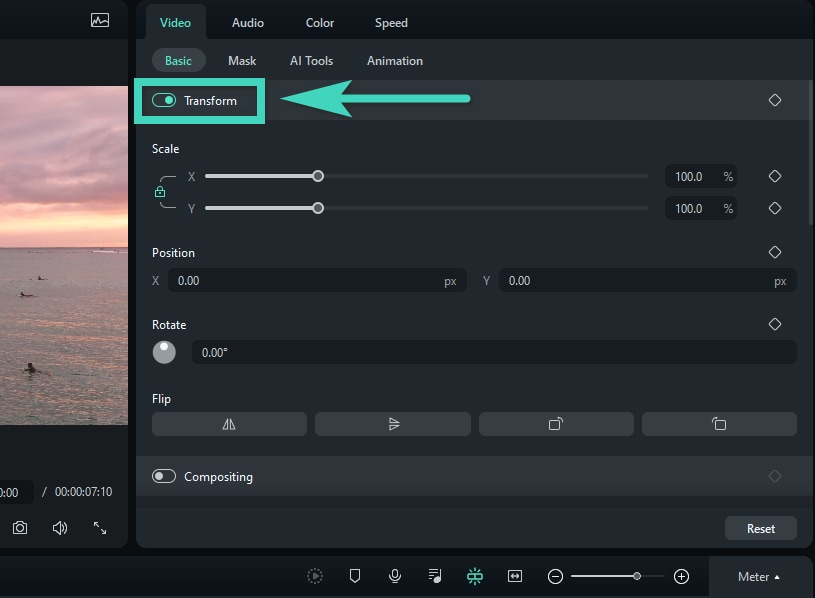
Four Uses of Transform
Here are four uses of the transform feature.
1. Resize Videos
Scale is used to resize the video. Drag the slider of X to change the width and the slider of Y to change the height.
The width and height would be changed in the origin ratio together by default. You can click the lock button if you want to change one of them separately.
2. Rotate or Flip Videos
Under the Flip tab, there are four choices, You can click the Horizontal, Vertical, Clockwise, or Counterclockwise icon to rotate the clip. Otherwise, insert a value in the box beside Rotate, or drag the dot in the circle, to adjust the angle of the clip.
3. Change Position
If you want to change the location of the video, you can apply the Position feature.
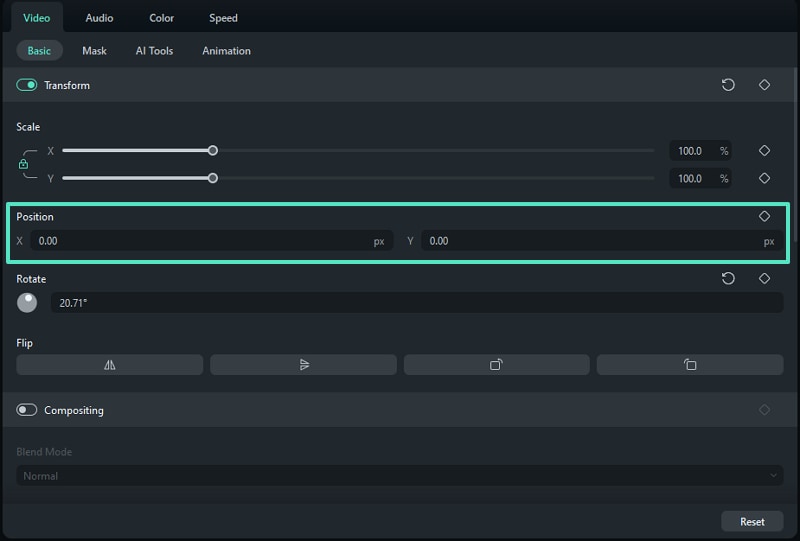
4. Add Keyframes
If you want to add customized animation of transforming in some parts of the video, you need to apply keyframes. The following are steps to add keyframes.
Step 1: Add the start keyframe
Drag the playhead to where you want to add a start keyframe. After adjusting the clip, click the diamond icon beside the features.
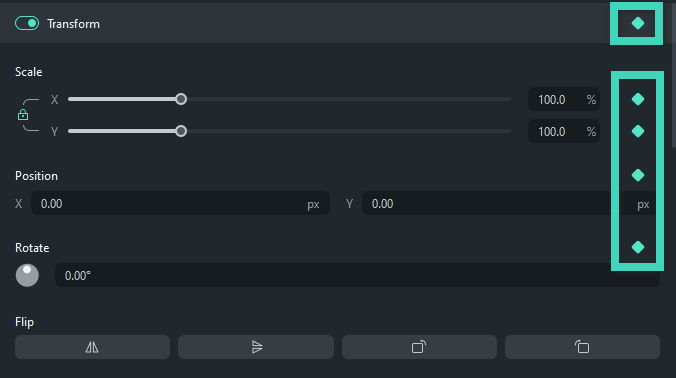
Note: If you click the diamond icon beside Transform on the toolbar, all the features in this section will be added to the keyframe.
Step 2: Add other keyframes
Repeat step one to add more keyframes. You can add many keyframes as you want. The minimum number of keyframes to complete the animation is two, one for the start and the other for the end.
When you are done, Filmora will analyze and output a natural animation, connecting the different keyframes.
New Feature: Place Your Anchor Point Anywhere!
Ever wanted to rotate an object from its corner instead of its center? Now you can! The anchor point is the heart of all transformations, like rotating. While it starts at the center of your clip, you can move it to gain full creative control.
Here’s how to change its position:
1- For Precise Control: Under the Transform settings, you'll find Anchor Point. Just type in the exact coordinates you want.
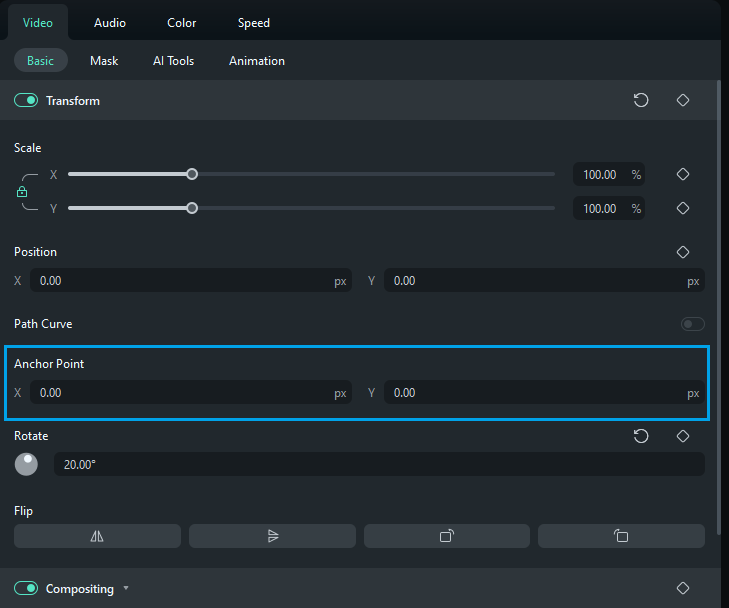
2- For Visual Ease: Simply select your clip on the preview screen. You'll see the anchor point icon. Click and drag it anywhere you like to reposition it instantly!
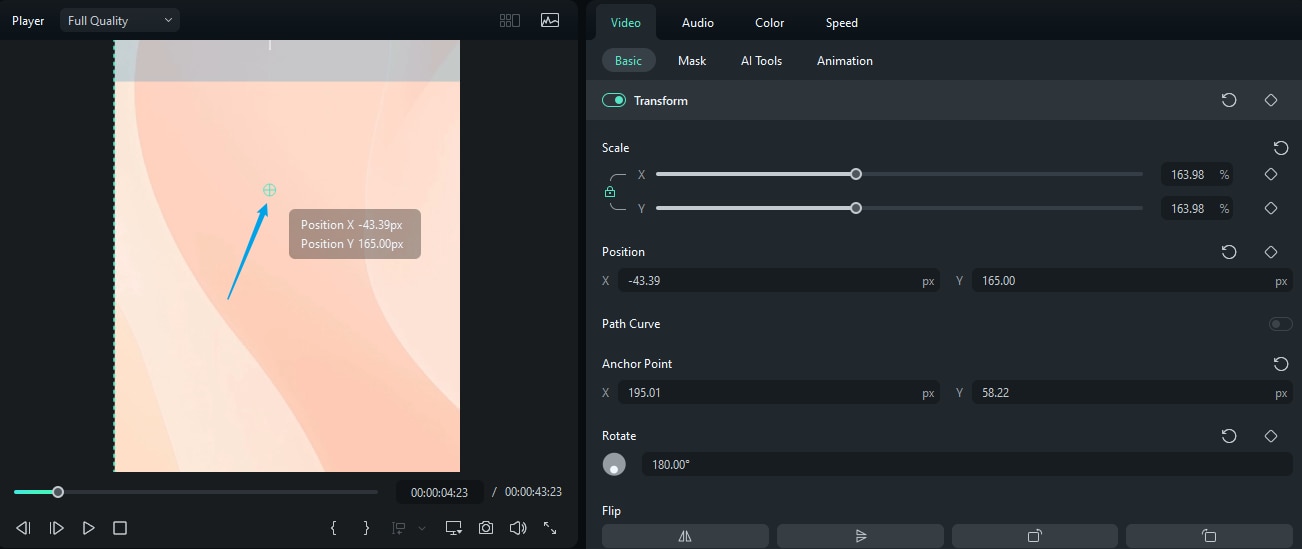
Related Posts
Featured Articles
How to Add Song Lyrics on Instagram Story & Reels (With or Without the App)
Adding lyrics to your Instagram Story or Reel is easy. Discover editing tips, step-by-step instructions, and creative ways to make your content stand out!
How to Motion Blur on CapCut Desktop | Online | Mobile?
If you are curious about how to motion blur on the CapCut desktop, online, and in the app, here are the details.
Everything You Need to Know about Text on Path in Inkscape
Learn how to add curve text in Inkscape to elevate designs with this step-by-step guide. Discover how this design technique can bring more value to your business, content, or projects.
Recommended User Guide
Play video in reverse on Mac
It it necessary to play video in reverse in certain circumstances. Here we are going to tell you how to use Filmora to play video in reverse.
Enable/Disable Clip for Mac
In professional video editing, the ability to hide and unhide clips holds significance for enhancing the editing process.
Select All Clips on Timeline for Mac
Knowing how to select clips both forwards and backwards on the timeline is essential. This feature allows you to select multiple clips at once, saving you time and effort when editing larger projects.
